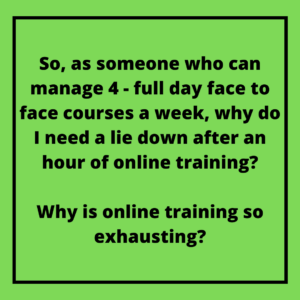As with many people I have had to change my businesses focus, as a freelance trainer my role is the antithesis of social distancing. As a result, I have moved my business to offer online solutions coaching, training, webinars… So as someone who can manage 4 full day face to face courses a week without really breaking a sweat, why do I need a lie down after an hour of online training? Why is online training so exhausting?
I have broken this down into 4 different areas that I think are relevant to me, please pop any thoughts you have in the comments.
A quick caveat, I am not complaining! I have absolutely loved the training I’ve done so far. Lloyds Bank Academy, UpSKill Digital, University of Hertfordshire and my own digital marketing courses have been great fun. This is just a thought piece as I’ve seen similar posts from training professionals and wanted to put my oar in.
Sitting down while training
Unless you have a cameraman, a studio set up and a production team, the likelihood is that you will be training from a seated position staring into a webcam. This is not a natural way to train.
My training style is very kinetic and demonstrative. Although all courses need moments of stillness, they also need movement and perspective changes to help maintain energy, focus and engagement. Also, movement breaks tension, either physical or mental. Changing position allows your body to free up and muscles to relax. It also provides a break for candidates to readjust and refocus their attention, literally changing their perspective.
Sitting in one place for an hour staring at a screen (even if you can see candidates video links) builds physical tension. Your shoulders, back and neck tighten and the need for constant unbroken focus is mentally tiring too. You can’t stand up and wander about. Perhaps have a little stretch beforehand and afterwards as well.

You have no control over your training space.
I am obsessively early to training locations. I want to understand the space and make the necessary adjustments to make it comfortable for me and the attendees. I prefer a U shape for tables as everyone can see everyone, and it makes interaction much easier. I will change tables around myself if necessary. Or something as simple as moving the flip chart stand (I miss flip charts) to the right of the room as I am left-handed, and it is more comfortable that way round.
With online training you are at the mercy of the webinar platform you are using (more on this in the next section). You can make your physical environment comfortable, a nice cushion on the seat, laptop raised (and slippers). But during the session, you must comply with the layout and functionality of the system you are using. It is possible that this enforced layout adds to your discomfort.

Soooo many virtual training platforms.
This is likely to be specific to freelancers, like me, who work for lots of different organisations. But in the 6 weeks of lockdown, I have delivered training on 6 different online training platforms.
Skype, Zoom, WebEx, MS Teams, OBS and LiveStorm (So far, I have no doubt there are more to come). My experience of online training was limited to 1-2-1 meetings via Skype for the University of Herts up to this point. Now, fortunately, I am very online literate and tech-savvy so adapting to these different systems is not a massive problem. However, they are all very similar, but different enough to cause the occasional pause or reset moment. In the heat of the moment, you forget which one you are on or must search for a button that was on the left yesterday but is on the right today. It means an increase in concentration that you wouldn’t have in a space you can control. This just adds to the mental energy you are expending.
The lack of immediate feedback
This is the big one for me, whether training 6 people or delivering a seminar to 100. When face to face you can gauge and react to feedback whether directly through questions or indirectly through body language. You can create interaction through something as simple as a show of hands or by making eye-contact. Any trainer worth their salt will see if a candidate is struggling and be able to alter tack to make sure they get the best out of the session.
This is, almost, entirely absent in online training. If you have a small group you can use video chat to keep them engaged and involved, but even if there is a second of lag due to internet connection, that can break the energy or have people inadvertently talking over each other. Another thing you can’t control (I’m not a control freak by the way). But with small video conferenced groups at least you can see their faces.

Lloyds Bank Academy Survive and Thrive Seminar. I'm on the right and the excellent John Chablo managed the chat and Q&A elements.
You are talking to yourself
With large seminars, the first I delivered for Lloyds Bank Academy had about 100 people, when I started the seminar, I couldn’t see any of them. Now WebEx (the best platform I’ve delivered on) like all the other provides a means to get interaction, Q&A section, chat section and raising of hands. The Lloyds presentations have these interactive elements build into them and they do work exceptionally well. Giving the trainer an opportunity to use candidate names, thank them for their contribution and break that fixation on the camera.
Essentially, though, you are talking to yourself for an hour. You have no idea if the candidates are on their phones, popped to the loo or have left the room entirely. You must have absolute faith in your ability to keep engagement almost solely through a tiny webcam and your experience and expertise as a trainer. This, for me, is the most exhausting part.
Why is online training so exhausting?
This stems from several small factors that together combine to make online training physically and mentally tiring. Fixed seated position, single focus, lack of feedback, inability to control the environment and an element of self-doubt.
Is there anything we can do? (Other than have a nice nap)
Solution? Well as trainers we all know that practice makes perfect. Few of us have had to do this level of online training before. It is new and newness, in itself, is tiring. I Have no doubt that I will find that after a few more courses this will even itself out. But in the interim you can think about the areas you can control.
Make your workspace as comfortable as possible, raise your laptop so the camera is at eye level (removing some of the tension caused by looking down), cushion for your seat, drinks on hand (hydration is so important) maybe even a nice comfy pair of slippers.
Get prepared, set up your screen sharing slides and resources, know where they are and practice swapping between them. Play with the chat function and if you have a moderator set up polls, questions etc in advance with them so they are ready and you are in control.

Enjoy it, because we still get to train
But most importantly enjoy it. It is a new challenge, but this is the way training will be moving for a while. I don’t see us flocking to crowded conference centres or packed training rooms for a while yet. Online is a solution and thanks to some amazing platforms a viable one at that.
However, we still get to do the thing that we love. All other challenges aside, we as trainers still get to make a difference, we get to inspire people, allow them to develop and learn skills that they can use to build their business, job search, hobbies or lives. That’s not a bad payoff for a bit of exhaustion really.
Online digital marketing training?
Courses available beamed directly to your home working desk via the power of Zoom.